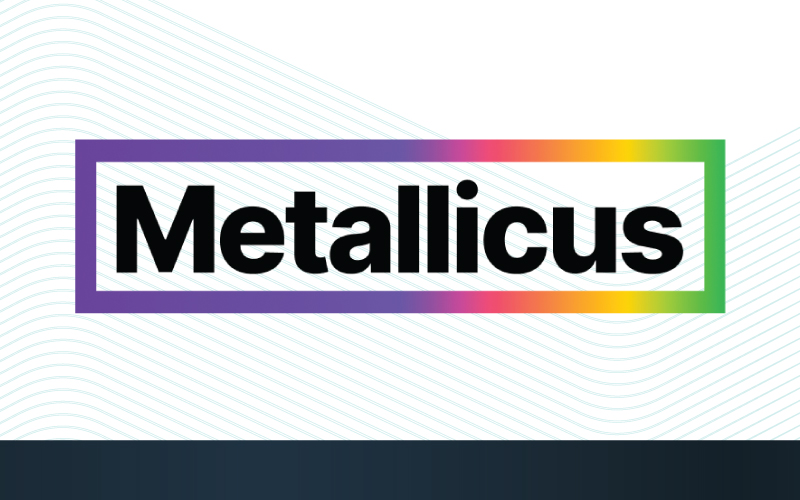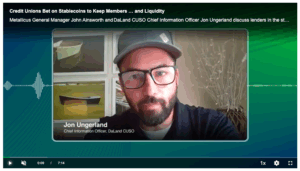Credit Unions Bet on Stablecoins to Keep Members…and Liquidity
October 1, 2025

By
When it comes to digital assets, credit unions and regional banks are entering an “act now” moment.
The point isn’t to turn community institutions into crypto startups. It’s to make digital asset capabilities feel like just another account type or collateral class in the core system. Think: something staff can service and auditors can recognize.
Some are moving fast to embrace that moment. St. Cloud Financial Credit Union (SCFCU), a Minnesota community lender, plans to launch its own stablecoin, Cloud Dollar (CLDUSD), by the end of the year. The digital asset will be native to the Metal blockchain from Metallicus and rely on software from DaLand for integration to the credit union’s banking core.
To hear more, PYMNTS sat down with John Ainsworth, general manager at Metallicus; and Jon Ungerland, chief information officer of DaLand CUSO.
Their collective warning to the community banking space was blunt: If members move liquidity to digital assets platforms that can also lend and settle payments through stablecoins, community institutions risk being disintermediated from their own revenue engines.
“A bout 18 months ago, it was pretty consistently 1% of deposits leaving institutions on a monthly basis and going to crypto exchanges. Earlier this year, it was about 3%. Now we’re seeing it, you know, edge up to 5% for our clients,” explained Ungerland. “If you’re in the money business and your competitor can do it exponentially faster, cheaper and safer than you, then you can’t compete.”
bout 18 months ago, it was pretty consistently 1% of deposits leaving institutions on a monthly basis and going to crypto exchanges. Earlier this year, it was about 3%. Now we’re seeing it, you know, edge up to 5% for our clients,” explained Ungerland. “If you’re in the money business and your competitor can do it exponentially faster, cheaper and safer than you, then you can’t compete.”
And in the past, community institutions could wait for standards to congeal and vendors to battle it out. In the stablecoin era, the “wait and see” window is narrowing.
“You used to think you’ve got three to five to seven years to kind of think this through. That’s no longer the case… staying on the sideline is not an option,” said Ainsworth.
As financial services move on-chain, community financial institutions are increasingly faced with the choice to either plug in or risk being routed around.
“Mathematically, if you’re looking at a 5% per month deposit flight, you have a very easily-derivable number of months that your business model can be relevant,” added Ungerland.
Credit Unions, Stablecoins and the Race to Modernize Money
One through-line across the conversation was an insistence that digital assets shouldn’t live in a parallel universe outside of banking. A symbiotic existence is possible, and is in fact emerging: something more akin to bridging, where credit unions keep deposits, loans, payments and customer relationships intact while connecting to newer networks for storage and settlement.
“What we’ve built is a bridge to allow traditional financial institutions to connect to these new worlds of DLT and decentralized money movement and storage,” explained Ungerland. “We see stablecoins as the doorway through which everyone’s going to have to walk into this broader world of digital assets.”
“Credit unions need to be able to use digital assets as deposits. They need to be able to use it for loan collateral. They need to be able to use it to generate payment income and revenues… and they’re not going to be able to do any of that if they’re not first and foremost vaulting the digital assets inside their traditional FI,” he added.
After all, the quickest way for credit unions to turn the stablecoin moment into a credit union advantage is by making digital assets feel ordinary in the core, so members don’t have to leave the community to live and transact in the future.
Still, if the concept sounds straightforward, the execution isn’t always as simple. Payments veterans have seen too many promising pilots stall at the last mile of integration.
Ainsworth, who comes from the card networks world, doesn’t romanticize the plumbing.
“Every payment solution we talk through, at the end of the day, the integration always becomes either the enabler or the roadblock, right? Always the case,” he said.
His own team’s approach to the Metal Blockchain, he added, is to treat blockchain as an enabler while centering the discipline banks already know: compliance, security and member trust.
“The compliance-first piece of that is very important,” said Ainsworth.
After all, once a compliance framework, vendor stack and member education strategy are in place, replication becomes far easier.
Moving From Digital Asset Pilots to Stablecoin Playbooks
In one sense, the stablecoin race resembles the early adoption of mobile banking. The first credit unions to offer apps were outliers. Within a few years, member demand made mobile a baseline expectation. Today, stablecoins may occupy that same early adopter phase, on the edge of moving from novelty to necessity.
What credit unions bring to the table is community trust. If they can pair that with the speed and efficiency of stablecoins, they could carve out a distinctive position in the digital economy, one that looks very different from the speculative crypto world.
“Interoperability for us is an absolutely crucial element of this… a member consumer… might have a credit union stablecoin, they still have USDC or what have you, they might have another consortium coin. And so the ability for that member to be able to have that kind of flexibility and that interoperability, we think that’s key,” explained Ainsworth.
“The utility of that payment rail, the consumer may not even know that there’s a stablecoin behind it. It’s just a new, faster, more efficient, cheaper, safer rail,” he added.
The near-term horizon will test whether stablecoins can truly integrate into the mainstream operations of CUs. The focus will likely be on use cases that align with credit unions’ mission: affordable remittances for immigrant communities, faster small-business payments, and streamlined member-to-member transfers.
The aim is to move the conversation from “can we do this?” to “here’s how we do this responsibly.”
Click HERE to the John Ainsworth and Jon Ungerland interview.
GoWest Solutions has partnered with Metallicus, the core developer of Metal Blockchain, to offer its members access to a collaborative Innovation Program focused on operationalizing Stablecoin use cases for the credit union industry. The Innovation Program, Stablecoin Pilot Sandbox, and Stablecoin Starter Kit are available free of charge to GoWest member credit unions. Reach out to the GoWest Solutions Team for more information or to receive your Stablecoin Starter Kit.
Posted in GoWest Solutions, Top Headlines.


















